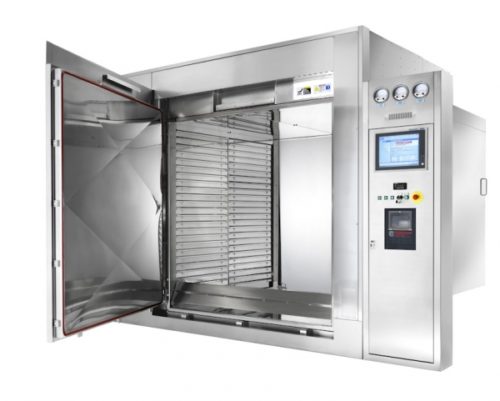Pharmaceutical sterilisation depyrogenation oven (FOD)
Sterilisation


The air that is being filled with the infused or emitted microparticles by the load during heat treatment (emissivity (stainless steel, glass, aluminium ...) ...
The air that is being filled with the infused or emitted microparticles by the load during heat treatment (emissivity (stainless steel, glass, aluminium ...) that is proportional to the temperature increase 20 ° C / 220 ° C) is constantly re-filtered through an original quality HEPA filtration wall to the left of the chamber (side view (1) non-sterile) before distributing the load.
The "high temperature" filters (different from those used for tunnels) are specifically degassed prior to use.
The calculation of the f (H) and F (T) values quantify the sterilising and depyrogenising effects. These units are controlled by the Thema4 system used by moist heat sterilisers.
NB: by analogy to oxygenation and (pyrogenation) pyrogenic reaction, the treatment leading to the controlled reduction of the concentration in elements that generate a fever should, etymologically, be called dépyrétogénation but the profession commonly but inaccurately employs the terms depyrogenation and pyrogens.
The "high temperature" filters (different from those used for tunnels) are specifically degassed prior to use.
The calculation of the f (H) and F (T) values quantify the sterilising and depyrogenising effects. These units are controlled by the Thema4 system used by moist heat sterilisers.
NB: by analogy to oxygenation and (pyrogenation) pyrogenic reaction, the treatment leading to the controlled reduction of the concentration in elements that generate a fever should, etymologically, be called dépyrétogénation but the profession commonly but inaccurately employs the terms depyrogenation and pyrogens.
APPLICATIONS
- Sterilisation Oven for the Pharmaceutical Industry.
PROCESS
Sterilisation
CARACTÉRISTIQUES TECHNIQUES
SERVICES
- Qualifications : IQ, OQ, PQ
- Validations
- Bespoke Maintenance
- Operator Training
CHARGES
Cartridges
Equipments
Flasks
Powders
DONNÉES TECHNIQUES
Pharmaceutical Steriliser: Structure in AISI 304 stainless steel with guaranteed high performance sealing. The insulation of the sterilisation oven is ensured by:
- compact rock wool, 100 mm high density for surface temperatures ext. <= 45 ° C operating at 240 ° C (BS 184).
- rigid ceramic at points of compression and dissipation of thermal bridging.
- a soft ceramic matrix connected to rockwool at the other junctions.
- excessive pressure regulated by high precision sensors
- perfectly "flush" finish, even in Class B
- temperature homogeneity <= +/- 4 ° c for homogeneous charge

